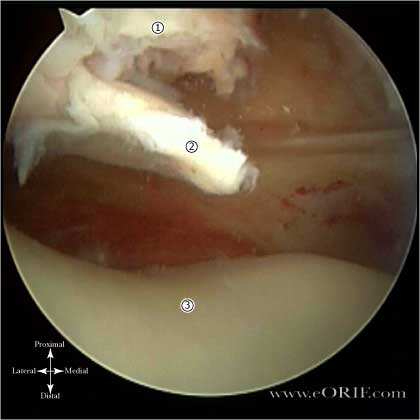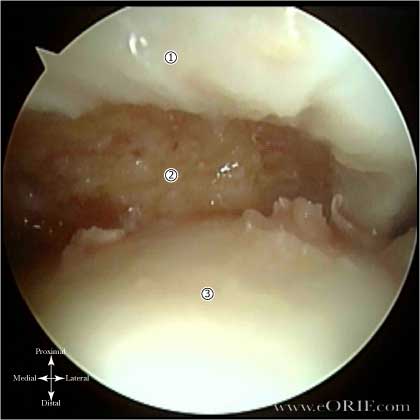|


|
synonyms: patella dislocation, patella instability, patellar instability, patellar dislocation, patellar subluxation, subluxation of patella
Patellar Dislocation ICD-10
Patellar Dislocation ICD-9
- 836.3 (closed patellar dislocation)
- 836.4 (open patellar dislocation)
- 717.85 (old disruption of other ligaments of knee; capsular ligament of knee)
Patellar Dislocation Etiology / Epidemiology / Natural History
- Often twisting force on a weight-bearing leg.
- Recurrence rate after first time patellar subluxation is low (Fithian DC, AJSM 2004;32:1114).
Patellar Dislocation Anatomy
- Patellar stability is dependent on: bony constraint of the femoral trochlea; MPFL, medial retinaculum, vastus medialis oblique. Any of these may be disrupted or dysplastic in patients with patellar instability. (Conlon T, JBJS 1993;75Am:682).
- >94% of patellar dislocations are related to MPFL rupture.
- 90% of MPFLruptures occur from its femoral origin on the adductor tubercle. (Sallay PI, AJSM 1996;24:52).
- See MPFL anatomy.
Patellar Dislocation Clinical Evaluation
- Generally report pain and knee popping out of place during a twisting injury. Large effusion.
- Tenderness along patellar tendon, peripatellar tissues and medial knee
- Patellar Apprehension: patella is pushed lateral with the knee in 20-30 degrees of flexion. A feeling of impending dislocation (apprehension) is a positive test.
- J-sign: lateral deviation of the patella in extension = patellar instability.
- Q-angle:
- Consider aspiration of associated hematoma. Fat in aspirate indicates intra-articular fracture.
Patellar Dislocation Xray / Diagnositc Tests
- A/P, lateral, sunriseview of affected knee. Often normal, evaluate for osteochondral fracture of medial facet or lateral trochlea.
- Evaluate for trochlear displasia on a true lateral xray with knee flexed 30°. Dysplasia is determined by the level of intersection of the projection of the trochlear floor with that of the lateral and medial condyle. (Dejour H, Knee Surg Sports Traumatol Arthroc 1994;2:19).
-Type I:
-Type II:
-Type III:
- Evaluate for patella alta:
- MRI generally indicated to assess for osteochondral defects. Demonstrates bony contusions on the lateral femoral condyle and medial patellar facet +/- osteochondral defects. (Elias DA, Radiology 2002;225:736).
Patellar Dislocation Classification / Treatment
- Acute Dislocation without osteochondral injury: short arc closed chain quadriceps/VMO strengthening. (Garth WP, AJSM 1996;24:785). Consider MPFL repair in young high level athletes who may have a high recurrence rate. Operative repair of an MPFL injury in the acute phase in skeletally immature children with a primary traumatic LPD significantly reduces the redislocation rate but does not improve subjective or objective knee function compared with a knee brace without repair. (Askenberger M, AJSM 2018;46(10):2328–2340)
- Acute Dislocation with osteochondral injury: surgical repair of large osteochondral injuries, excision of small fragments with MPFL repair.
- Chronic / Recurrent Dislocation: often associated with extensor mechanism malalignment. Consider distal realgnment (Trilat), lateral release, MPFL reconstruction. Isolated lateral relese in not sufficient. (Bellemans J, AJSM 1997;25:375).
- see also MPFL reconstruction
Patellar Dislocation Associated Injuries / Differential Diagnosis
- Chondral injury. Incidence= 40%. Generally medial patellar facet and/or lateral trochlea.
Patellar Dislocation Complications
- Anterior knee pain: 30-50%
- Arthrofibrosis
- Recurrent instability
- Stiffness
- Infection
- Patellofemoral arthritis
Patellar Dislocation Follow-up Care
- @58% of patients will have continued limitations in activity with strenous activity without recurrent dislocation 6 months after injury.
Patellar Dislocation Review References
- Fogel GR, JAAOS 2004;12:49
- Schepsis, AA, Rogers, AJ. Medial patellofemoral ligament reconstruction: indications and technique. Sports Med Arthrosc. 2012 Sep;20(3):162-70.
- Fithian DC, Paxton EW, Stone ML, Silva P, Davis DK, Elias DA, White LM. Epidemiology and natural history of acute patellar dislocation. Am J Sports Med. 2004 Jul-Aug;32(5):1114-21.
- °
|


